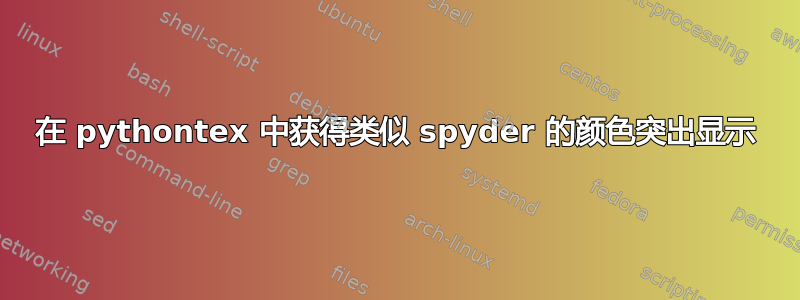
在使用 Python 3.4 时,我使用 spyder(anaconda3 2.0.1),并且我喜欢 Spyder 编辑器(版本 2.3)的突出显示功能。使用该pythontex包是否可以在 latex 文档中使用相同的突出显示方案?我在 Pygments 文档中没有找到这样的信息...
答案1
得票最多的答案是如何在 Latex 列表 lstinputlistings 命令中突出显示 Python 语法无法回答这个问题,因为它没有解决默认的 Spyder 突出显示问题。下面的示例(基于链接的示例)显示了如何使用默认的 Spyder 突出显示列出代码和输出(块和内联)。
此示例适用于 Python v3.x,即它是print一个函数而不是语句。它清楚地注释了如何自定义。
\documentclass[a4paper,12pt]{article}
% This is the default font in Spyder
\newcommand*{\pyfontfamily}{\fontfamily{DejaVuSansMono-TLF}\selectfont}
% These are close to the default font colors in Spyder
\usepackage{color}
\definecolor{pycommentcol}{rgb}{0.3,0.3,0.3} % gray
\definecolor{pystatecol}{rgb}{0,0,0.7} % blue
\definecolor{pystringcol}{rgb}{0,0.6,0} % green
\definecolor{pyinbuiltscol}{rgb}{0.55,0.15,0.55} % plum
\definecolor{pyspecialcol}{rgb}{0.8,0.45,0.12} % orange
% Python style for highlighting
% for help with listings
% see docs http://texdoc.net/texmf-dist/doc/latex/listings/listings.pdf
\usepackage{listings}
\newcommand\pythonstyle{\lstset{
language=Python,
basicstyle=\pyfontfamily,
commentstyle=\color{pycommentcol}\itshape,
emph={self,cls,@classmethod,@property}, % Custom highlighting
emphstyle=\color{pyspecialcol}\itshape, % Custom highlighting style
morestring=[b]{"""},
stringstyle=\color{pystringcol},
keywordstyle=\color{pystatecol}, % statements
% remove any inbuilt functions from keywords
deletekeywords={print},
% Switch to predefined class that contain many, but not all,
% inbuilt functions and classes
classoffset=1,
% add any inbuilts, not statements
morekeywords={print,None,TypeError},
keywordstyle=\color{pyinbuiltscol},
frame=tb,
showstringspaces=false
}}
% Python environment
\lstnewenvironment{python}[1][]
{
\pythonstyle
\scriptsize
\lstset{#1}
}
{}
% Python for inline
\newcommand\pythoninline[1]{{\pythonstyle\lstinline!#1!}}
% Python output style for highlighting
\newcommand\pythonoutstyle{\lstset{
basicstyle=\pyfontfamily,
showstringspaces=false
}}
% Python output environment
\lstnewenvironment{pythonout}[1][]
{
\pythonoutstyle
\scriptsize
\lstset{#1}
}
{}
% Python output for inline
\newcommand\pythonoutinline[1]{{\pythonoutstyle\lstinline!#1!}}
\begin{document}
\section{``In-text'' listing highlighting}
A docstring and some comments:
\begin{python}
"""
Created on Thu Feb 20 18:33:21 2020
@author: Alexander Pitchford
Some examples for testing listings in Latex aiming to match Spyder colours
This should be green!
"""
# This should be grey
# PEP8 says that lines should be no longer than 79 characters
# This is a completely full line of nonsense just to take up some space and see
# if it fits
\end{python}
\vspace{5mm}
\noindent A simple program:
\begin{python}
# Python program to add two numbers
a = 1
b = 3
mysum = a + b
print("The sum of ", a, " and ", b, " is ", mysum)
\end{python}
\noindent That outputs:
\begin{pythonout}
The sum of 1 and 3 is 4
\end{pythonout}
\vspace{5mm}
\noindent A function:
\begin{python}
def my_func(list_of_numbers):
"""sum the list items"""
try:
return float(sum(l))
except TypeError:
return None
l = [1, 'boo', 2]
print("The sum is", my_func(l))
\end{python}
\vspace{5mm}
\noindent A class:
\begin{python}
class MyClass(object):
def __init__(self, my, yours):
self.my = my
self.yours = yours
@property
def mine(self):
return self.my
\end{python}
\section{Inline highlighting}
Definition \pythoninline{class MyClass} means \dots
\end{document}



